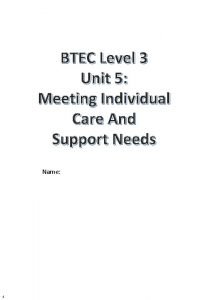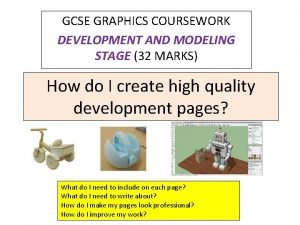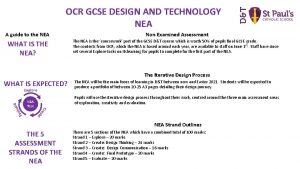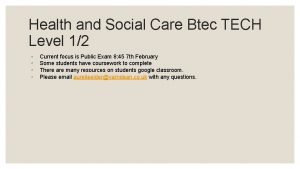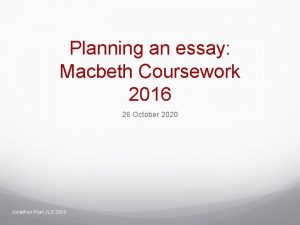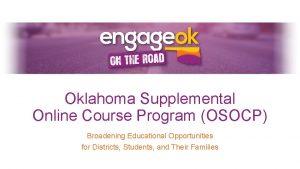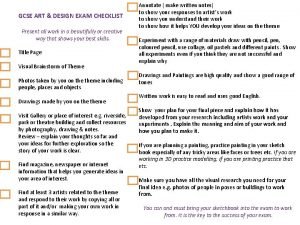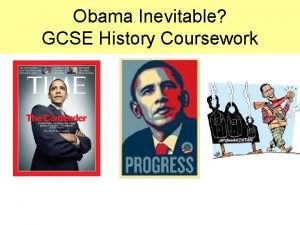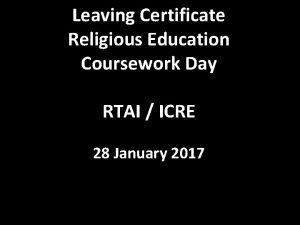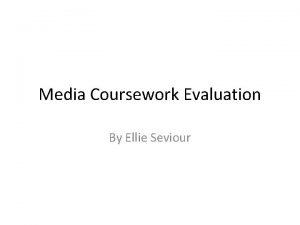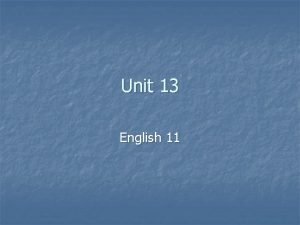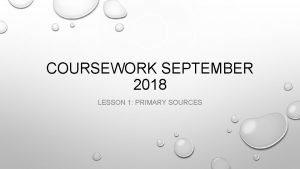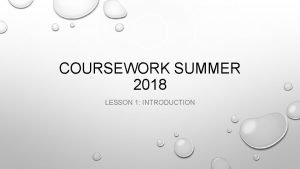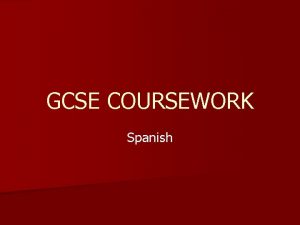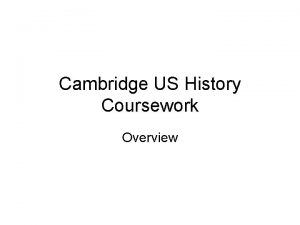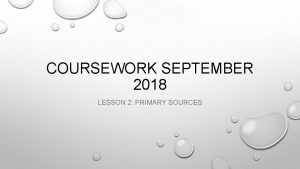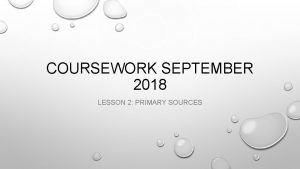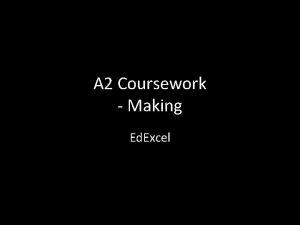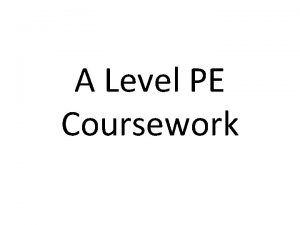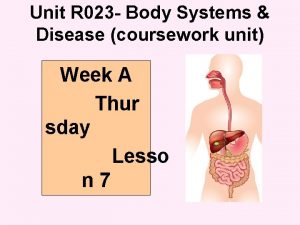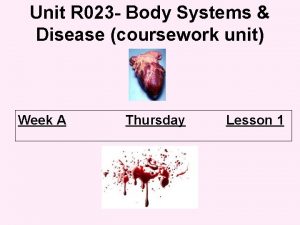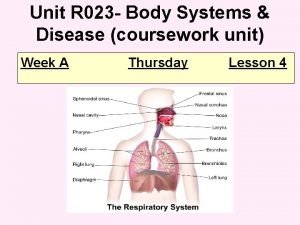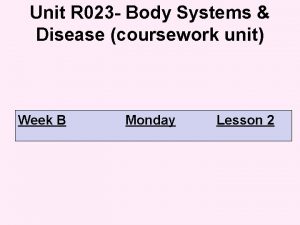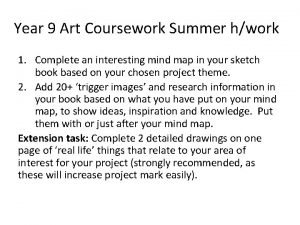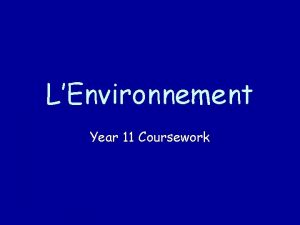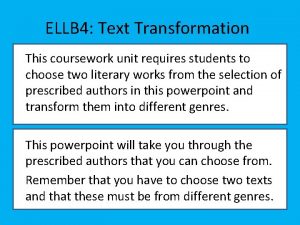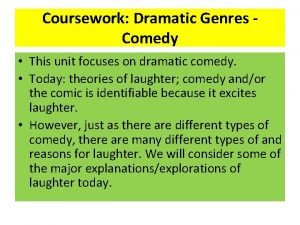Year 13 Unit 4 Coursework Year 13 coursework






























- Slides: 30

Year 13 Unit 4 Coursework

Year 13 coursework involves 2 tasks • Task 1(24 marks) – A talk – Written before full research begins – 600 -750 words – This is part of your prep for the final investigation but will be assessed – Think of it as a proposal and plan

Task 1 • AO 1 (6 marks) – Identify topic – Decide on methodology – Use appropriate terminology – Present coherently and structured

Task 1 • AO 4 (18 marks) – *Communicate appropriately* – Apply (some) linguistic theory

Possible layout for task 1: • 1) Introduction – try to get audience’s attention (remember you are writing for an audience!) • 2)Say why you’ve chosen his topic • 3)Define key terms • 4)Methodology – how will you go about your analysis • 5)Expectations/predictions/Challenges • 6)Conclusion

Task 2 • Task 2 (56 marks) – Written work – 2000 -2250 words – (therefore overall a maximum of 3000)

Task 2 • All 4 AOs assessed – AO 1 10 marks – Communicate your findings/ use terminology – AO 2 16 marks – Concepts, analysis of language and meanings – AO 3 16 marks – key constituents/context – AO 4 14 marks – use of English in different contexts

Task 2 • AO 1 (10 marks) – Identify/justify topic – Explain methodology – Use appropriate terminology – Present coherently and structured

Task 2 • AO 2 – Identify language concepts – Apply linguistic approaches (pragmatics, semantics, psycholinguistics, sociolinguistics etc) – Show significance of findings

Task 2 • AO 3 – Show understanding of context of area of study – Apply key constituents appropriately

Task 2 • AO 4 (18 marks) – Communicate appropriately – Apply (some) linguistic theory

Layout for Task 2 • Introduction • Methodology • Analysis • Conclusion • Evaluation

Intro • Introduce your topic (a bit like summing up Task 1)

Methodology • This is where you show that you haven’t just jumped straight in, that you have given some thought to HOW you will analyse. Why have you decided to look for certain patterns, features etc?

Analysis • This should be the MAIN part of the essay. It depends on your topic as to how you do this. It should be as scientific as possible, i. e. Stick with the evidence in front of you. Be analytical, not discursive or interpretative. Use some statistics, maybe even a chart. (Could bring in theories here and test them against your data. )

Conclusion • Sum up your findings here. • Did your findings fit in with your expectations as stated in task 1? • Did your findings confirm theorists?

Evaluation • How did it go? • What were the challenges? • Did your findings tally with your expectations? • What did you feel worked well? • What would you do differently if you did this again?

Some example questions • A hypothesis – If a child’s regional accent affects the way the child spells certain words, then similar spelling errors will appear in the work of children with similar accents but not in the work of children with other, different accents.

Some example questions • A question – How does a newspaper create bias or try to influence the opinions of readers? This might need to be more specific or even turned into a hypothesis

Some example questions • A descriptive approach – The language of my peer group is very different from the language of our parents. This observation suggests that a new variety is developing that may not have been described. Describing the distinctive features of this language could be a valid investigation.

Some things you might have to do • Define an area for investigation • Collect data / create a corpora • Design/apply a questionnaire • Use basic statistical analysis • Apply a range of analytical techniques • Reference all sources

A Suggested approach • Identify data • Collect and record data • Write draft of methodology • Produce task 1 article/talk

Suggested approach • Begin analysing data (transcribe if necess) • Make notes etc • Begin first draft of findings • Write introduction • Produce first draft • Edit, rewrite. • Submit final investigation

An example of Task 1 • Question – How does a 4 year-old’s awareness of writing develop over a six-month period?

An example of Task 1 Introduction (On children’s writing)

An example of Task 1 (Intro and) Main Body • On the development of pragmatic skills in children’s language

An example of Task 1 Introduction

An example of Task 1 Introduction (Continued) and Main Body

An example of Task 1 Conclusion

So, continue developing your question or thesis, start collecting data and begin putting together a methodology….
 Unit 14 health and social care
Unit 14 health and social care Unit 5 learning aim c health and social care
Unit 5 learning aim c health and social care Unit 10, unit 10 review tests, unit 10 general test
Unit 10, unit 10 review tests, unit 10 general test Year 6 leavers poems
Year 6 leavers poems Creative imedia coursework deadline
Creative imedia coursework deadline Gcse graphics coursework
Gcse graphics coursework Verna and sam williams case study
Verna and sam williams case study Horizontal anatomical plane
Horizontal anatomical plane Design technology gcse coursework examples
Design technology gcse coursework examples Btec
Btec Nea english literature a level ideas
Nea english literature a level ideas Macbeth coursework
Macbeth coursework Oklahoma supplemental online course program
Oklahoma supplemental online course program Wjec media studies past papers
Wjec media studies past papers Gcse art annotation format
Gcse art annotation format How to cite the guardian apa
How to cite the guardian apa Gcse history coursework
Gcse history coursework Religion coursework
Religion coursework Media magazine coursework
Media magazine coursework Design technology gcse coursework
Design technology gcse coursework Gcse pe coursework action plan
Gcse pe coursework action plan English year 6 unit 13
English year 6 unit 13 Metode pembiayaan semi langsung
Metode pembiayaan semi langsung Hyp opp adj triangle
Hyp opp adj triangle Si units mass
Si units mass Unit test unit test review algebra 2
Unit test unit test review algebra 2 Contoh unit cost rekam medis
Contoh unit cost rekam medis Unit process and unit operation
Unit process and unit operation What is unit operation and unit process
What is unit operation and unit process Kerangka konseptual standar akuntansi pemerintahan
Kerangka konseptual standar akuntansi pemerintahan Forward rate notation
Forward rate notation

